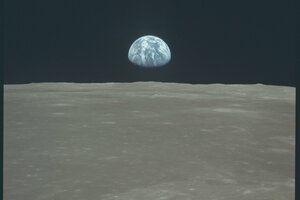Why Apollo missions still inspire
The 50th anniversary of the first moon mission and a new movie on Neil Armstrong are good reasons to recall how this cosmic venture lifted humanity.

Earth rises above the moon's horizon during the Apollo 11 lunar mission in July 1969.
Reuters
A half-century ago this week (Oct. 11) Apollo 7 rode a pillar of fire into Earth’s orbit. It marked the beginning of one of the most remarkable feats of exploration in human history, the Apollo moon missions. By the time the final Apollo crew splashed into the Pacific Ocean a little more than four years later, 12 astronauts aboard six Apollo spacecraft had landed on the moon. They became the first humans to leave Earth and explore another celestial body.
A just-released feature film, “First Man,” retells the story of Neil Armstrong, the astronaut who made the first boot marks in the lunar dust. His small step off Apollo’s lander in July 1969 became a “giant leap for mankind.” Only eight years had passed since President John F. Kennedy had committed the United States to land the first human on the moon by the end of the decade.
The Apollo program has been credited with kick-starting a scientific revolution that exploded in the following decades, a technological path that can be traced down to today’s computers and cellphones.
In December 1968, the crew of Apollo 8 circled the moon, conducting tests in preparation for Armstrong’s landing the following summer. It was the first time humans had ventured beyond Earth’s orbit. On Christmas Eve, in a rare moment of downtime, astronaut Bill Anders glanced out the spacecraft’s window and was awestruck by what he saw. He quickly grabbed a camera and snapped a picture of a blue-and-white sphere emerging in the blackness of space above the lunar horizon. The photo became known as “Earthrise,” often referred to today as one of the most famous and influential photos ever taken. (Two other views of Earth from space, “The Blue Marble” and “The Pale Blue Dot,” have also achieved iconic status.)
“To see the earth as it truly is, small and blue and beautiful in that eternal silence where it floats, is to see ourselves as riders on the earth together,” wrote poet Archibald MacLeish shortly after, “brothers on that bright loveliness in the eternal cold – brothers who know now they are truly brothers.”
No national boundaries can be seen. No wars or political infighting are visible. The view became a symbol for environmental responsibility as well. This “cosmic oasis, cosmic blue pearl,” as Indian poet Abhay Kumar later called the planet, is the one and mutual home of all humanity, the stage for the whole human story, surrounded by a void of seemingly endless space. It merits tender, thoughtful care.
As more details of the historic moon missions are retold in the coming years, more of the immense meaning of these epic journeys will unfold to each generation. The Apollo missions will have another chance to perhaps inspire new achievements that will once again lift human thinking to a new orbit.

